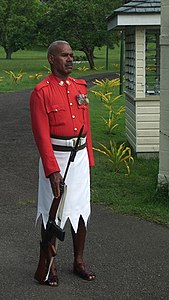Sulu (skirt)
A sulu is a kilt-like garment worn by men and women in Fiji since colonisation in the nineteenth century.
Etymology The word sulu (pronunciation: soo-loo) literally means clothes or cloth in the iTaukei language.
The first sulus were brought by missionaries coming from
It consists of a rectangle of cloth of varying length, between below-knee and ankle-length, wrapped around the hips and traditionally fastened by tying at the waist or has an elastic waist. Modern men's sulus may be fastened with buckles.[3] This version of the sulu is believed to have been designed for formal wear by Ratu Sir Lala Sukuna.
The casual or everyday unisex sulus are known as sulu-vaka-toga (meaning Tongan sulu). Together with women's church or formal ceremony dress, simple sulus with an elastic waist that extend to the ankles are known as sulu-i-ra. The more elegant full-length ones for dressy occasions as sulu jaba.[4] Men's sulus are known as sulu vakataga (sulu with pockets).
Tailored sulus with pockets are commonly worn as part of Fijian men's business and formal wear,[4][5][6] with shirt and sandals and optionally western-style jacket and tie. In certain situations, such as entering a church, wearing a sulu is seen as respectful.[7] Tailored sulus also feature in police and military uniforms.[8] Official uniform sulus come to below the knees and feature a distinctive zigzag hem.
In Fiji the sulu is seen as an expression of ethnic Fijian identity. While wearing a sulu is often mandatory for Fijians in certain settings,[9][10] previously, members of other ethnicities were sometimes discouraged from wearing it.[11] Nowadays, it is pleasant to see all races wearing the sulu.
References
- ^ "Clothing and dress in Fiji". Go-Fiji.com. Archived from the original on 2011-09-03. Retrieved 2011-11-01.
- ^ Brewster, Adolph (1922). The Hill Tribes of Fiji. London: Seeley. p. 25.
- ^ Sitiveni Rabuka (2007-05-27). "Sukuna and native land". Fiji Times. Archived from the original on 2013-11-02. Retrieved 2013-11-01.
- ^ a b "Skirts for men, or everything you always wanted to know about the sulu". 2013-06-16. Archived from the original on 2013-11-06. Retrieved 2013-11-01.
- ^ Frederica Elbourne (2012-10-05). "Get ready for the sale". Fiji Times. Archived from the original on 2013-11-02. Retrieved 2013-11-01.
- ^ "People & Culture of Fiji Islands". Fiji.ResortsPacific.com. Archived from the original on 2013-11-03. Retrieved 2013-11-01.
- Perth Now. Archived from the originalon 2013-12-10. Retrieved 2013-11-01.
- New York Times. Archivedfrom the original on 2013-11-14. Retrieved 2013-11-01.
- ^ "Media dress code mooted". Fiji Times. 2007-04-12. Archived from the original on 2013-11-02. Retrieved 2013-11-01.
- ^ Serafina Silaitoga (2010-10-15). "T-shirt ban on women". Fiji Times. Archived from the original on 2013-11-02. Retrieved 2013-11-01.
- ^ Theresa Ralogaivau (2010-02-06). "Sulu uproar". Fiji Times. Archived from the original on 2013-11-02. Retrieved 2013-11-01.
12. The Sulu is not a traditional garment https://thestylander.com/the-sulu/


